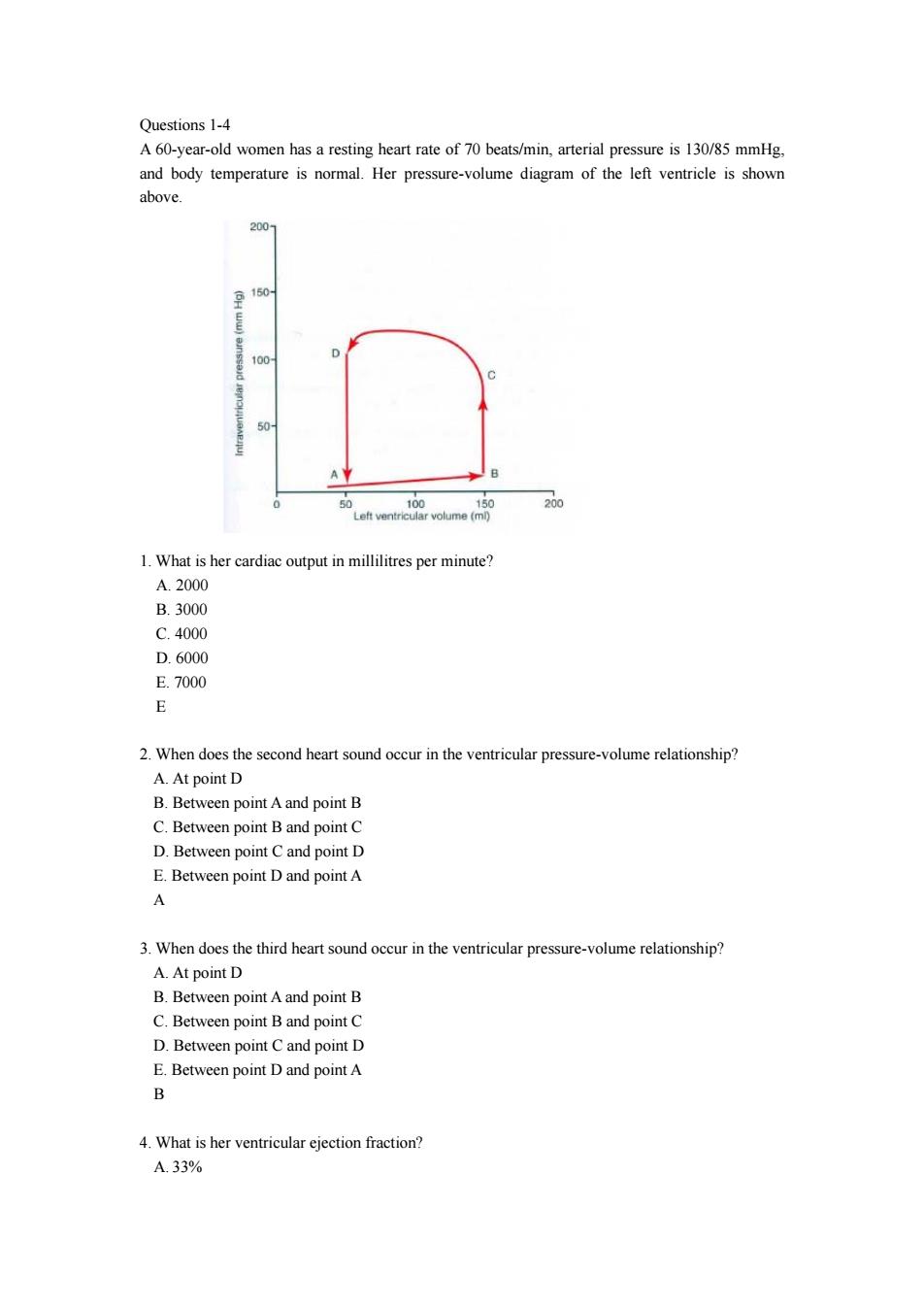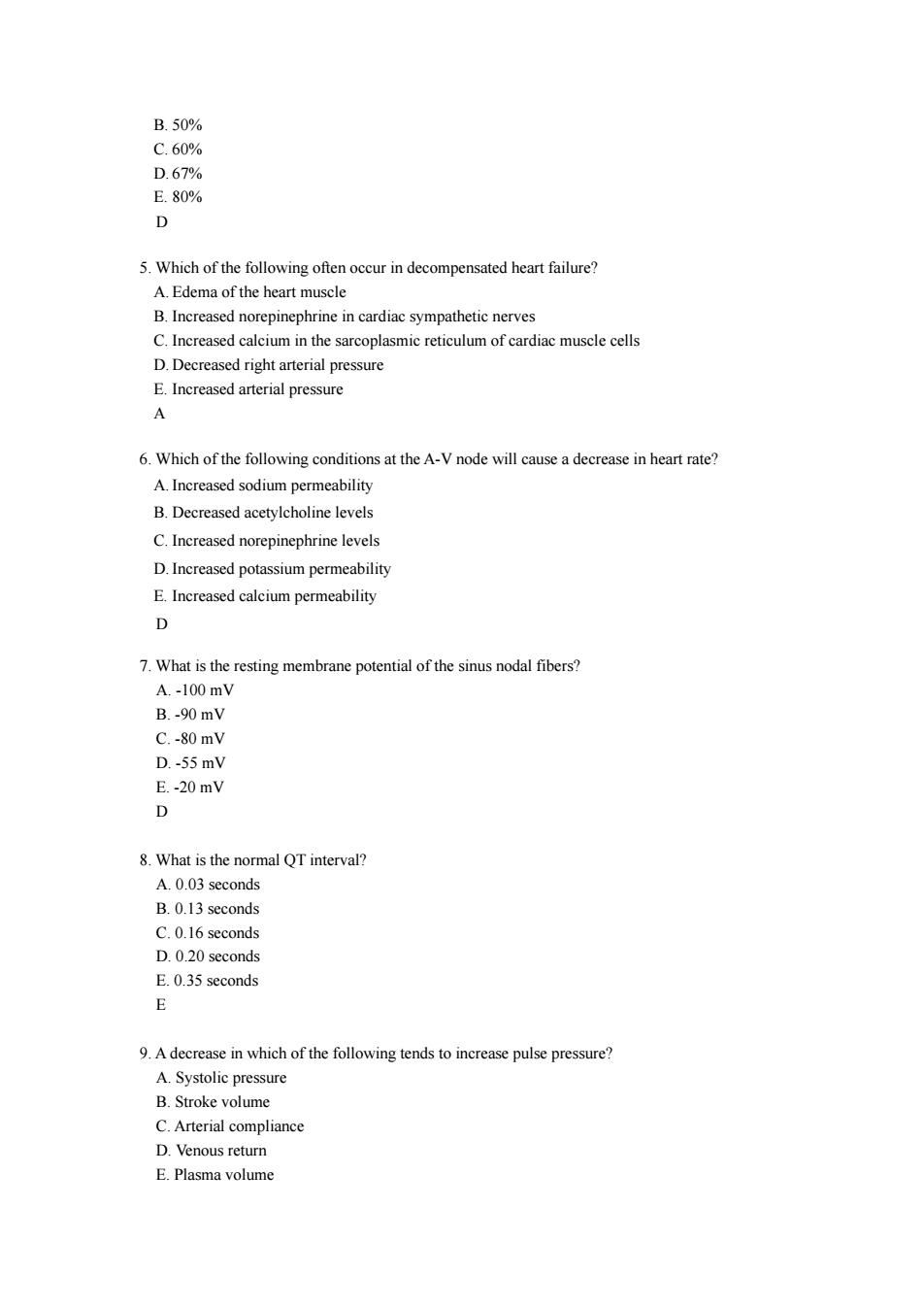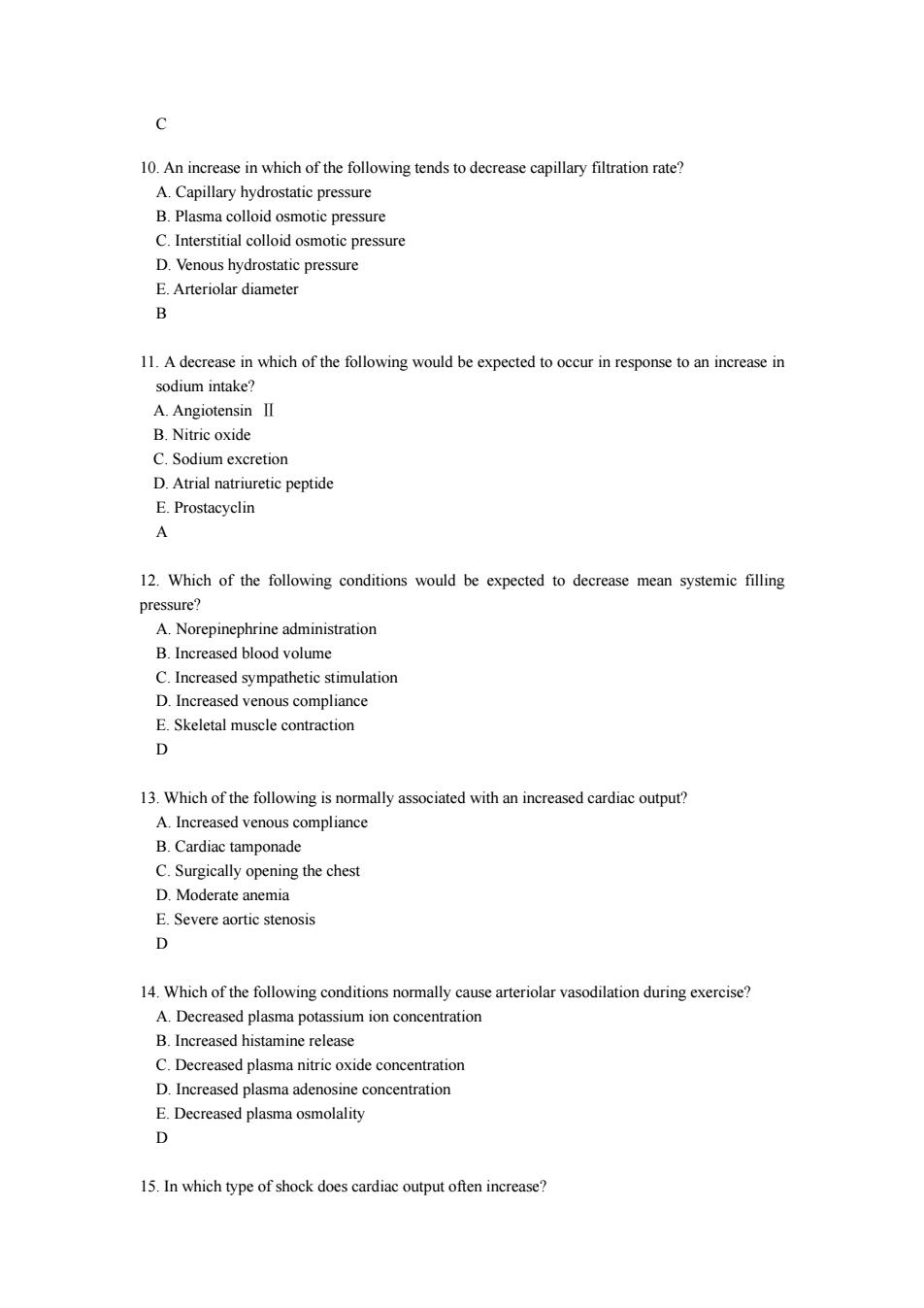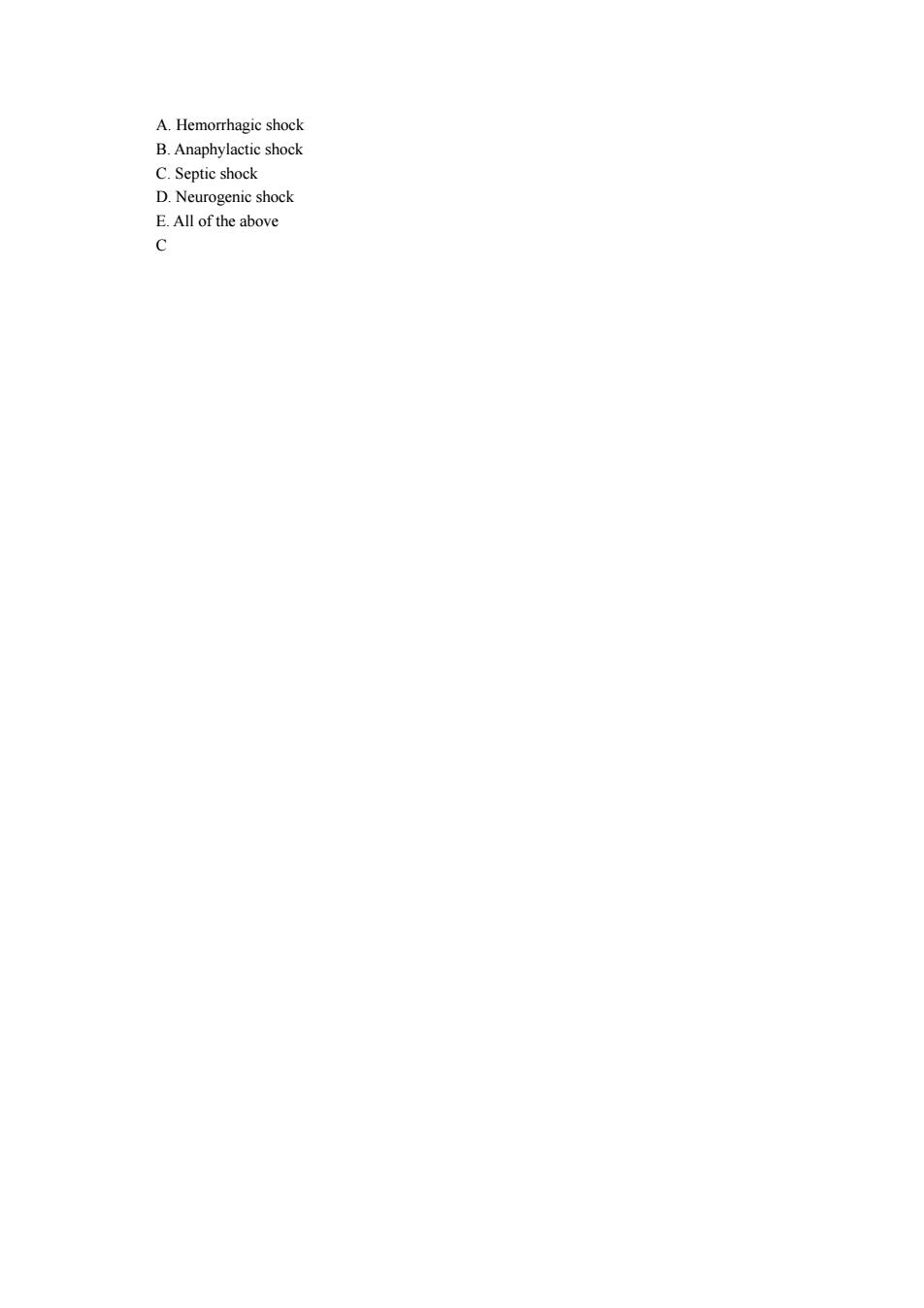
Questions 1-4 A 60-year-old women has a resting heart rate of 70 beats/min,arterial pressure is 130/85 mmHg. and body temperature is normal.Her pressure-volume diagram of the left ventricle is shown above. 200 150 1.What is her cardiac output in millilitres per minute? A.2000 B.3000 C.4000 D.6000 E.7000 E 2.When does the second heart sound occur in the ventricular pressure-volume relationship? A.At point D B.Between point Aand point B C.Between point B and point C D.Between point C and point D E.Between point Dand pointA A 3.When does the third heart sound occur in the ventricular pressure-volume relationship? A.At point D B.Between point A and point B C.Between point B and point C D.Between point C and point D E.Between point D and point A B 4.What is her ventricular ejection fraction? A.33%
Questions 1-4 A 60-year-old women has a resting heart rate of 70 beats/min, arterial pressure is 130/85 mmHg, and body temperature is normal. Her pressure-volume diagram of the left ventricle is shown above. 1. What is her cardiac output in millilitres per minute? A. 2000 B. 3000 C. 4000 D. 6000 E. 7000 E 2. When does the second heart sound occur in the ventricular pressure-volume relationship? A. At point D B. Between point A and point B C. Between point B and point C D. Between point C and point D E. Between point D and point A A 3. When does the third heart sound occur in the ventricular pressure-volume relationship? A. At point D B. Between point A and point B C. Between point B and point C D. Between point C and point D E. Between point D and point A B 4. What is her ventricular ejection fraction? A. 33%

B.50% C60% D 5.Which of the following often occur in decompensated heart failure? A.Edema of the heart muscle B.Increased nore incardiac sympathetic nerve D.Decreased right arterial pressure E.Increased arterial pressure 4 6.Which of the following conditions at the A-V node will cause a decrease in heart rate? A.Increased sodium permeability B.Decreased acetylcholine levels C.Increased norepinephrine leve D.Increased potassium permeability E.Increased calcium permeability D 7.What is the resting membrane potential of the sinus nodal fibers? A.-100mV B-90mV C.-80mV D.-55 mV E.-20 mV D 8.What is the normal QT interval? A..03 seconds B.0.13 seconds C.0.16 seconds D.0.20 seconds E 0.35 seconds 9.Adecrease in which of the following tends to increase pulse pressure? A.Systolic pressure B.Stroke volume C.Arterial compliance D.Venous retur E.Plasma volume
B. 50% C. 60% D. 67% E. 80% D 5. Which of the following often occur in decompensated heart failure? A. Edema of the heart muscle B. Increased norepinephrine in cardiac sympathetic nerves C. Increased calcium in the sarcoplasmic reticulum of cardiac muscle cells D. Decreased right arterial pressure E. Increased arterial pressure A 6. Which of the following conditions at the A-V node will cause a decrease in heart rate? A. Increased sodium permeability B. Decreased acetylcholine levels C. Increased norepinephrine levels D. Increased potassium permeability E. Increased calcium permeability D 7. What is the resting membrane potential of the sinus nodal fibers? A. -100 mV B. -90 mV C. -80 mV D. -55 mV E. -20 mV D 8. What is the normal QT interval? A. 0.03 seconds B. 0.13 seconds C. 0.16 seconds D. 0.20 seconds E. 0.35 seconds E 9. A decrease in which of the following tends to increase pulse pressure? A. Systolic pressure B. Stroke volume C. Arterial compliance D. Venous return E. Plasma volume

c 10.An increase in which of the following tends to decrease capillary filtration rate? A.Capillary hydrostatic B.Plasma C.Interstitial colloid osmotic pressure D.Venous hydrostatic pressure E.Arteriolar diameter B 11.A decrease in which of the following would be expected tooccur in response to an increase in sodium intake? A Angiotensin II B.Nitric oxide C.Sodium excretion D.Atrial atriuretic peptide E.Prostacyclin A 12.Which of the following conditions would be expected to decrease mean systemic filling ure? A.Norepinephrine administration B.Increased blood volume C.Increased sympathetic stimulatior D.Increased venous compliance E.Skeletal muscle contraction D 13.Which of the following is normally associated with an increased cardiac output? A.Increased venous compliance B.Cardiac tamponade C.Surgically open ng the ches D.Moderate anemia E.Severe aortic stenosis D 14.Which of the vasodilation A.Decreased plasma potassium ion concentration B.Increased histamine release C.Decreased plasma nitric oxide concentration D.Increased plasma adenosine concentration E.Decreased plasma osmolality D 15.In which type of shock does cardiac output often increase?
C 10. An increase in which of the following tends to decrease capillary filtration rate? A. Capillary hydrostatic pressure B. Plasma colloid osmotic pressure C. Interstitial colloid osmotic pressure D. Venous hydrostatic pressure E. Arteriolar diameter B 11. A decrease in which of the following would be expected to occur in response to an increase in sodium intake? A. Angiotensin Ⅱ B. Nitric oxide C. Sodium excretion D. Atrial natriuretic peptide E. Prostacyclin A 12. Which of the following conditions would be expected to decrease mean systemic filling pressure? A. Norepinephrine administration B. Increased blood volume C. Increased sympathetic stimulation D. Increased venous compliance E. Skeletal muscle contraction D 13. Which of the following is normally associated with an increased cardiac output? A. Increased venous compliance B. Cardiac tamponade C. Surgically opening the chest D. Moderate anemia E. Severe aortic stenosis D 14. Which of the following conditions normally cause arteriolar vasodilation during exercise? A. Decreased plasma potassium ion concentration B. Increased histamine release C. Decreased plasma nitric oxide concentration D. Increased plasma adenosine concentration E. Decreased plasma osmolality D 15. In which type of shock does cardiac output often increase?

A Hemorrhagic shock B.Anaphylactic shock C.Septic shock D.Neurogenic shock E.All of the above C
A. Hemorrhagic shock B. Anaphylactic shock C. Septic shock D. Neurogenic shock E. All of the above C